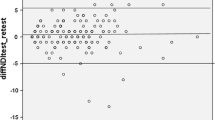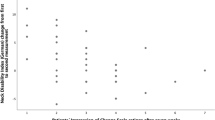Abstract
A prospective cohort study with a 1 week follow-up. To examine the reliability and responsiveness of the Dutch version of the Neck Disability Index (NDI) in patients with acute neck pain in general practice. An increasing number of studies on treatment options is published in which the NDI is used. Reports of the ability of the NDI to detect change over time, often called responsiveness, however have not yet been published. At baseline 187 patients (119 women, 68 men) were included. They completed a questionnaire on demographic variables, self-reported cause of their complaints and the NDI. After 1 week, 86 patients were sent the NDI again together with the perceived recovery scale which was used as our external criterion. The scale ranged from 1 (complete recovery) to 7 (complaints are worse than ever). Response rate was 93%. Test–retest scores on reliability were good (ICC = 0.90). A Bland and Altman plot and a graph of total sum score differences showed no visible tendency towards unequal spreading of the data. For patients that reported on the perceived recovery scale that they were “stable” we found a responsiveness ratio of 1.82. The standard error of measurement (SEM) was 0.60 what resulted in a minimal detectable change (MDC) of 1.66. The NDI has shown to be a reliable and responsive instrument in patients with acute neck pain in general practice.



Similar content being viewed by others
References
Ackelman BH, Lindgren U (2002) Validity and reliability of a modified version of the Neck Disability Index. J Rehabil Med 34:284–287
Ariēns GAM, Borghouts JAJ, Koes BW (1999) Neck pain. Crombie IK, Epidemiology of pain, IASP Press, Seattle pp 235–255
Beurskens AJHM, Vet de HCW, Kõke AJA (1996) Responsiveness of functional status in low back pain: a comparison of different instruments. Pain 65:71–76
Boehm H, Greiner-Perth R, El-Sahir H et al (2003) A new minimally invasive posterior approach for the treatment of cervical radiculopathie and myelopathy: surgical technique and preliminary results. Eur Spine J 12:268–273
Bogduk N (1999) The neck. Baillières Clin Rheumatol 13:261–285
Boninger ML, Cooper RA, Fitzgerald SG et al (2003) Investigating neck pain in wheelchair users. Am J Phys Med Rehab 82:197–202
Borghouts JAJ, Koes BW, Bouter LM (1998) The clinical course of non-specific neck pain: a systematic review. Pain 77:1–13
Bot SDM, Terwee CB, Windt van der DAWM et al (2004) Clinimetric evaluation of shoulder disability questionnaires: a systematic review of the literature. Ann Rheum Dis 63:335–341
Bovim G, Schrader H, Sand T. (1994) Neck pain in the general population. Spine 19:1307–1309
Bunketorp L, Nordholm L, Carlsson J (2002) A descriptive analysis of disorders in patients 17 years following motor vehicle accidents. Eur Spine J 11:227–234
Chiu TTW, Lam TH, Hedley AJ (2001) Subjective health measures used on Chinese patients with neck pain in Hong Kong. Spine 26:1884–1889
Côté P, Cassidy JD, Carroll L (1998) The Saskatchewan health and back pain survey. The prevalence of neck pain and related disability in Saskatchewan adults. Spine 23:1689–1698
Donk van der J, Schouten JSAG, Passchier J et al (1991) The associations of neck pain with radiological abnormalities of the cervical spine and personality traits in a general population. J Rheumatol 118:1884–1889
Guez M, Hildingsson C, Nilsson M et al (2002) The prevalence of neck pain. A population based study from northern Sweden. Acta Orthop Scand 73:455–459
Guez M, Hildingsson C, Stegmayr B et al (2003) Chronic neck pain of traumatic and non-traumatic origin. A population based study. Acta Orthop Scand 74:576–579
Guyatt GH, Kirshner B, Jaeschke R (1992) Measuring health status: what are the necessary measurement properties? J Clin Epidemiol 45:1341–1345
Guyatt GH, Walter S, Norman G (1987) Measuring change over time: the usefulness of evaluative instruments. J Chron Dis 40:171–178
Hains F, Waalen J, Mior S (1998) Psychometric properties of the Neck Disability Index. J Manipulative Physiol Ther 21:75–80
Hoving JL, O’Leary EF, Niere KR et al 2003) Validity of the neck disability index, Northwick Park neck pain questionnaire, and problem elicitation technique for measuring disability associated with whiplash-associated disorders. Pain 102:273–281
Kjellman G, Skargren E, Oberg B (2002) Prognostic factors for perceived pain and function at one-year follow-up in primary care patients with neck pain. Disabil Rehabil 24:364–370
Koes BW, Bouter LM, van Mameren H et al (1994) A randomized trial of manual therapy and physiotherapy for persistent back and neck complaints: subgroup analysis and relationship between outcome measures. J Manipulative Phys Ther 16:211–219
Köke AJA, Heuts PHTG, Vlayen JWS et al (1996) Neck Disability Index. Pijn Kennis Centrum Maastricht. Meetinstrumenten chronische pijn. Maastricht pp 52–54
Marchiori DM, Henderson CNR (1996) A cross-sectional study correlating cervical radiographic degenerative findings to pain and disability. Spine 21:2747–2752
McHorney CA, Ware JR jr. (1995) Construction and validation of an alternate form general mental health scale for the medical outcomes study short-form 36-item health survey. Med Care 33:15–28
Miettinen T, Leino E, Airaksinen O et al 2004) The possibility to use simple validated questionnaires to predict long-term health problems after whiplash injury. Spine 29:E47-E51
Ostello RWJG, de Vet HCW (2005) Clinically important outcomes in low back pain. Best Pract Res Clin Rheumatol 19:593–607
Ostello RWJG, de Vet HCW, Knol DL, van den Brandt PA (2004) 24-item Roland Morris Disability Questionnaire was preferred out of six functional status questionnaires for post-lumbar disc surgery. J Clin Epidemiol 57:268–276
Peolsson A, Hedlund R, Vavruch L et al (2003) Predictive factors for the outcome of anterior cervical decompression and fusion. Eur Spine J 12:274–280
Peterson C, Bolton J, Wood AR et al (2003) A cross-sectional study correlating degeneration of the cervical spine with disability and pain in United Kingdom patients. Spine 28:129–133
Pietrobon R, Coeytaux RR, Carey T et al (2002) Standard scales for measurement of functional outcome for cervical pain and dysfunction. A systematic review. Spine 27:515–522
Riddle DL, Stratford PW (1998) Use of generic versus region-specific functional status measures on patients with cervical spine disorders. Phys Ther 78:951–963
Vernon HT, Mior S (1991) The Neck Disability Index: a study of reliability and validity. J Manipulative PhysTher 14:407–415
Vet de HC, Bouter LM, Bezemer PD, Beurskens AJ (2001) Reproducibility and responsiveness of evaluative outcome measures. Theoretical considerations illustrated by an empirical example. Int J Technol Assess Heath Care 17:479–487
Westaway MD, Stratford PW, Binkley JM (1998) The patient-specific functional scale: validation of its use in persons with neck dysfunction. J Orthop Sports Phys Ther 27:331–338
Windt van der DAWM, Heijden van der GJMG, Winter de AF, Koes BW et al (1998) The responsiveness of the shoulder questionnaire. Ann Rheum Dis 57:82–87
Author information
Authors and Affiliations
Corresponding author
Rights and permissions
About this article
Cite this article
Vos, C.J., Verhagen, A.P. & Koes, B.W. Reliability and responsiveness of the Dutch version of the Neck Disability Index in patients with acute neck pain in general practice. Eur Spine J 15, 1729–1736 (2006). https://doi.org/10.1007/s00586-006-0119-7
Received:
Revised:
Accepted:
Published:
Issue Date:
DOI: https://doi.org/10.1007/s00586-006-0119-7




